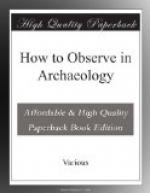Pottery. As in Age II, plain, polished, rarely ring-burnished, but of less careful workmanship (VIII, Fig. 9.) Glazed albarelli, ’pilgrim-bottles’, aryballi, &c., (as in Age III) common. White-yellow slipped ware with bands of black survives rarely from Age III.
Stone vessels.
Bowls on inverted cup-shaped feet not uncommon (VIII,
Fig. 11).
Beads and seals. Eye-beads in mosaic glass, and other glass beads (hard stone and bronze more rarely): conoid seals in hard crystalline stones, usually engraved with figure praying to the Moon-god: also soft stone, glass and paste conoids. Scarabs and scaraboids in paste. Cylinders become scarce.
V. Hellenistic. VI. Roman. VII. Byzantine.
Most of the characteristic Syrian products of all these Periods do not differ materially from those found in other East Mediterranean lands, e.g. Greece and Asia Minor. The change to Persian (Sassanian) types comes in the late seventh century A.D.
Two classes of objects, examples of the first of which are mostly of Age III, but may be Persian, Hellenistic, or even Roman, are very commonly met with in Syria:
1. Figurines, single or in pairs or threes, of bronze or terra-cotta, representing cult-types. Most common is a standing god with peaked cap, short tunic, and arm raised in act of smiting: a seated goddess also common: figures of animals, especially a bull; and phallic objects (these mainly Roman).
2. Glass plain (iridescent from decay), ribbed, or moulded, in great variety of forms-bowls, jugs, cups, &c. Mostly late Hellenistic, Roman, and Byzantine, and especially common and of fine quality in the Orontes valley.
Parti-coloured glass (with white or yellow bands and threads) is earlier (Persian Period). Painted and enamelled glass with gilt or polychrome designs is later (ninth to fifteenth century, Arab).
[ILLUSTRATION IX: SYRIAN WEAPONS, ETC.]
CHAPTER VI
PALESTINE
[See the diagrams of flint implements, Illustrations II; pottery, XII; alphabets, XIV & XV.]
I. General Principles.
1. Study of the pottery of the country, not merely from books but from actual specimens, is an absolutely essential preliminary. Without an acquaintance with this branch of Palestinian archaeology, so thorough that any sherd presenting the least character can be immediately assigned to its proper period, no field research of any value can be carried out. (See further V below.)
2. A knowledge of the various Semitic alphabets is necessary for copying inscriptions. Unless the traveller be also acquainted with the languages he had better be cautious about copying Semitic inscriptions; without such knowledge he runs the risk of confusing different Semitic letters, which often closely resemble one another. He should, however, be able to make squeezes and photographs.




